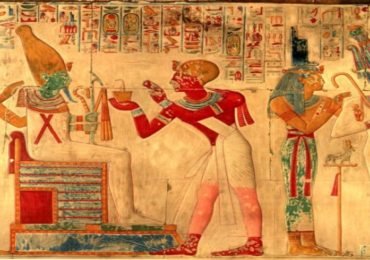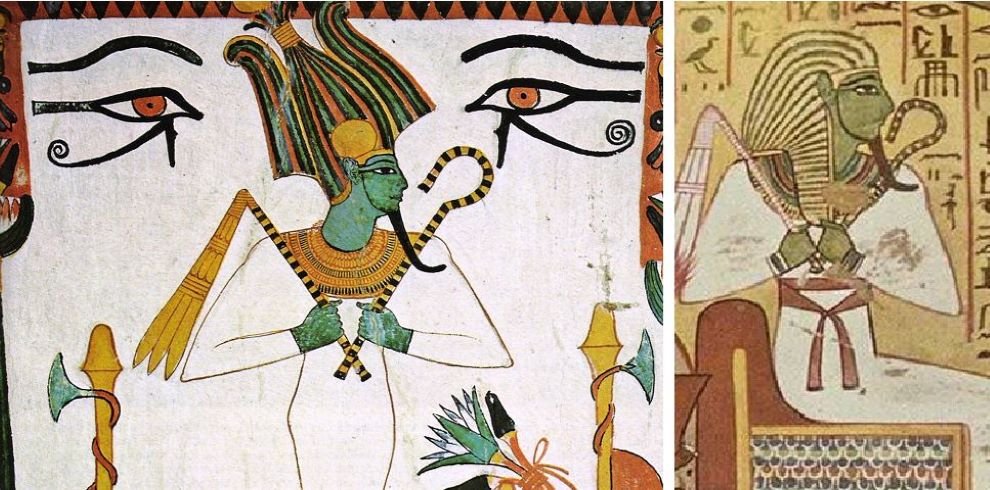God Osiris was one of the most popular and beloved gods among the ancient Egyptian deities. Osiris was the all-merciful, the Just Judge of the dead who oversaw one’s life on earth and in the afterlife. He also was considered the first king of Egypt who established the cultural values all later kings were sworn to uphold. Also, he was considered as an actual historical character; a ruler of Egypt in the dawn of Egypt’s history.
Name of Osiris
Osiris’s name is derived from the Egyptian “wsr” which means “power” or “powerful” or “mighty”. Later on, Osiris was known by many names but chiefly as “Wennefer”, (The Beautiful One). He was also known as the Lord of Love, King of the Living, and the Eternal Lord.
His Origin
The origin of Osiris is unknown. Actually, we don’t know when exactly Osiris lived and reigned in Egypt, not at what time he was deified. Some scholars believe that Osiris lived in the Delta, and his original center was Busiris. An ancient god named Andjety was worshipped at Busiris. This god was represented holding the crook and flail like Osiris and two plumes above his head.
When Busiris became the northern cult center of Osiris. The two gods, Osiris and Andjety became fused together in the minds of the people.
Osiris at the same time was called the “Lord of Abydos” which was his southern cult center of him. Some scholars think that “Khenti-Amentiu” was the oldest representation of Osiris at Abydos. “Khenti-Amentiu” means “the First of the Westerners”. Amentiu or “Westerners” is a word used to refer to the dead in ancient Egypt.
One important reason that Osiris came from Abydos, is he always represented wearing the white crown of Upper Egypt. It was the spread of the cult of Osiris that was the cause of the rapid development and importance of Abydos. Which became the most sacred spot in all Egypt. It was the duty of every Egyptian to make a pilgrimage there, at least once in his lifetime, in order to visit the tomb of Osiris.
Images of Osiris
 He was classically depicted as a green-skinned deity with a pharaoh’s beard, partially mummy-wrapped at the legs, wearing a distinctive atef crown, and holding a symbolic crook and flail. Osiris, sometimes depicted with black skin symbolizing the fertile mud of the Nile and regeneration.
He was classically depicted as a green-skinned deity with a pharaoh’s beard, partially mummy-wrapped at the legs, wearing a distinctive atef crown, and holding a symbolic crook and flail. Osiris, sometimes depicted with black skin symbolizing the fertile mud of the Nile and regeneration.
Images of Osiris as a living god depict him as a handsome man in a royal dress wearing the crown of Upper Egypt as a plumed headdress known as the “atef” and carrying the crook and flail, symbols of kingship, or the flail represents the fertility of his land while the crook symbolizes the authority of his rule.
Worship of Osiris
The worship of Osiris may have begun at a very early date. His worship spanned thousands of years from shortly before the Early Dynastic Period to the Ptolemaic Dynasty. Before the fifth Dynasty, only the kings were articulate and the tombs of the wealthy members are devoid of religious texts. By the beginning of the fifth Dynasty, the name of Osiris had crept into the private tombs.
Osiris was originally a fertility god. But by the begging of the fifth Dynasty, Osiris had a dual role. He was a god of fertility and god of death and underworld. This dual role had its impact on the concept of the Egyptian divine kingship. The pharaoh at death as Osiris, god of the underworld, and the dead pharaoh’s son, the living Pharaoh was Horus, the god of the sky.
By the beginning of the Middle Kingdom (2000 BCE) everybody, not just the dead pharaoh was identified as Osiris at their death. The pharaohs were mummified as Osiris. Their appearance as Osiris himself would not only remind them of the god but also would drive away dark spirits by fooling them into thinking one was the great god himself.
At Memphis, the holy bull, Apis, was linked with Osiris becoming Osiris-Apis, which eventually became the name of the Hellenistic god Serapis. Osiris was also identified with Soker, an ancient Memphite god of the Dead.
Every year, on the occasion of the annual pilgrimage, a sacred play was enacted in Abydos, portraying events in the life, death, and resurrection of Osiris as in the myth below. Priests and people took part in this play, and often the king himself, or his special representative, took the part of Horus.
Myth of Osiris & Isis
God Atum gave birth to his son Shu (air) and his daughter Tefnut (moisture). Shu married Tefnut and gave birth to Geb (earth) and Nut (sky). Geb married Nut and gave birth to Osiris, Isis, Seth, Nephthys, and Horus the Elder. Osiris married to Isis, and the divine pair became the rulers of Egypt. At that time, Egypt was not a proper country. People were nomadic hunters, knew nothing of reading and writing, and had no settled government.
Osiris taught them the arts of agriculture, of writing, and helped them to live an orderly, enlightened life, and his Queen Isis shared his labors. Egypt became a paradise under Osiris rule. Where everyone was equal and there was abundant food as the crops were always plentiful.
Seth, their evil brother, was jealous of the love that the Egyptians bore for the good god Osiris. Seth was truly mad after Nephthys, disguised herself as Isis, and seduced Osiris, becoming pregnant with the god Anubis. He decided to get rid of his brother and seize the throne of Egypt for himself. He invited Osiris to a large banquet with another 72 followers of Seth. Seth told his guests, he had a golden coffin as a gift to anybody will fit.
Seth’s Plot
Everyone started to try getting into the coffin. One is shorter, one is taller, one is thinner, and one is fatter than the coffin. But when Osiris went into the coffin, it was perfectly matching him. Osiris started to happily scream, it is mine my brother. Seth, replied, yes it is yours, and it looks like the coffin you should die inside. Seth and his followers closed the coffin over Osiris and threw it into the River Nile. By this cunning trick, Seth proclaimed himself ruler of Egypt. The Nile carried the coffin to the Mediterranean sea and at last, it floated to Byblos in Lebanon.
The faithful wife and goddess Isis, started her job searching for the body of Osiris. After many weary journeys, she found it and brought it back to Egypt. She hid the dead Osiris in the Delta marshes. While Isis was away to bring some herbs helping her to return her husband to life. In one of Seth’s hunting trips in the Delta marches, he found his brother’s body. He was mad and tore his brother’s body into pieces. The number of pieces of the body of Osiris varies according to the sources from 14 to 42 pieces.
Seth scattered these pieces far and wide in Egypt to make it difficult for to Isis collect them again. He scattered all of them on Egypt’s ground but Osiris’s penis was thrown into the Nile River.
Isis Embalming Osiris
Once again Isis set out to find the pieces of her husband’s body. She wherever found a portion of it, she buried it and built a shrine to mark the spot. This tradition says that the head of Osiris was buried at Abydos. Thus, it became the most important of the burial places of Osiris. Another tale says that Isis collected all the pieces of the body of Osiris and buried them all at Abydos, after having magically re-united them. But in the place where she found each piece, she buried a wooden model.
Actually, Isis couldn’t find Osiris’s penis because the Oxyrhynchus fish ate it. Which is why this fish was forbidden food in ancient Egypt. So, Isis added a mud-penis to Osiris’s body to make it complete. Isis was able to revive Osiris and once he was alive. She assumed the form of a kite and flew around him, drew the seed from his body into her own, and became pregnant with a son, Horus. Later on, God Horus was born to revenge his father’s death by his uncle Seth. By then, Osiris chose to withdraw into the afterlife where he became lord and Judge of the Dead.
Horus grew to manhood and challenged the right of his evil uncle, Seth to the throne. After many fierce battles and other troubles, Horus finally overcome the murderer of his father and gained for himself the throne of Egypt. In some versions of the story, Seth is Killed by Horus. But, in most, he is defeated and driven from the land. Horus governed the land in the same high and just traditions laid down by Osiris and became the ideal model for every pharaoh, all of whom bore the title “Horus” until the end of the pharaonic regime.

